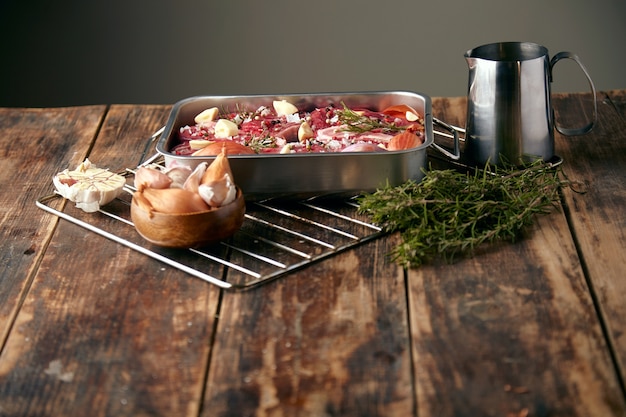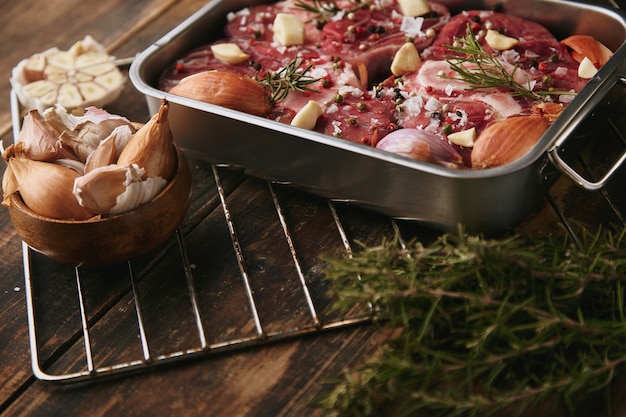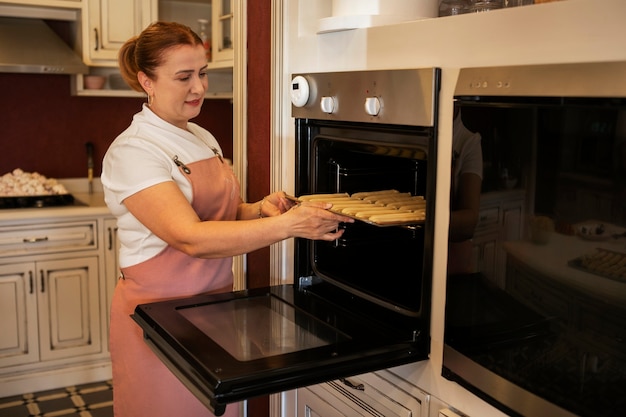Bacon. Oh, bacon. The mere mention of that crispy, salty, smoky goodness sends shivers down my spine. It's a breakfast staple, a lunch treat, and a dinner delight, and it somehow makes everything better. But as much as I love the sizzle of bacon in a pan, there's something about oven-baking it that takes it to a whole new level. It's not just about freeing up your stovetop for other culinary adventures; oven-baked bacon produces incredibly even results, and you can bake a whole batch at once! So, gather 'round, fellow bacon enthusiasts, and let's embark on a journey to unlock the secrets of achieving that perfect, crispy goodness in the oven.
(Part 1) The Basics of Oven-baking bacon

Don't be intimidated; oven-baking bacon is ridiculously simple. The basic concept is a breeze: you lay your bacon strips on a baking sheet, pop them into the oven, and let the magic happen. But like all things in the culinary world, there are a few key details that make a big difference.
1. choosing the right bacon
It all starts with the bacon itself. Now, I'm a firm believer in thick-cut bacon. It holds its shape better during baking, delivering that satisfyingly chewy texture that I crave. But thin-cut bacon has its own charms, especially if you're after a crispier bite. The choice is yours, my friend! This is where your personal preferences come into play.
2. Prepping Your Baking Sheet
Next up, the baking sheet. It's the stage for your bacon masterpiece. Choose a sheet that's big enough to accommodate your bacon strips without any overlap. This ensures that every piece cooks evenly, getting its fair share of heat. I've found that lining the sheet with parchment paper is a game-changer. It prevents sticking, which is a real lifesaver when it comes to cleanup. Plus, it's easier to get those perfectly crisp strips off the sheet without tearing them.
3. The Magic of Oven Temperatures
Temperature is everything! After years of experimentation, I've discovered that 400°F (200°C) is the sweet spot for oven-baked bacon. At this temperature, the bacon cooks beautifully, achieving that glorious golden-brown crispness without burning. It's a delicate balance, and this temperature seems to strike it just right.
4. Cooking Times: A Guide for perfect bacon
Here's where things get a bit more nuanced. The cooking time for oven-baked bacon depends on the thickness of your bacon and how crispy you like it. It's all about finding that sweet spot between perfectly cooked and a bit too much. Here's a general guide to get you started:
- Thin-cut bacon: 15-20 minutes
- Thick-cut bacon: 20-25 minutes
But remember, this is just a starting point. The key is to keep a close eye on your bacon. Watch for the edges to start curling, and the fat to render down, those are the telltale signs that your bacon is getting close to perfection. If you crave extra crispness, feel free to cook it a little longer. But be warned: it's much harder to reverse the process once you've overcooked it. So, keep a watchful eye!
5. The Art of Flipping
This is a tip that many people overlook. Flipping your bacon halfway through the cooking time is a game-changer! It ensures that both sides of the bacon get that beautiful golden-brown colour and achieve a uniform crispness. It's a simple yet crucial step for achieving perfectly cooked bacon.
(Part 2) Beyond the Basics: Tips for Taking Your Oven-Baked Bacon to the Next Level

Now that we've mastered the basics, let's delve into some clever techniques that will elevate your oven-baked bacon to a whole new level of deliciousness. These tips are based on years of trial and error, and they truly make a difference.
1. The Secret of Spacing
Remember I mentioned avoiding overlapping bacon? There's a reason for this! Spacing your strips allows for maximum airflow, which is essential for even cooking and crispy results. Imagine each bacon strip getting its own little breeze, allowing the heat to penetrate evenly. A good rule of thumb is to leave about half an inch between each strip. Give that bacon some breathing room!
2. The Power of a Baking Rack
This is a little-known secret that I swear by: a baking rack. Place it on top of your baking sheet, and then arrange your bacon strips on the rack. This allows air to circulate even more effectively, creating an even crispier bacon. It's like adding a turbo boost to your bacon-baking process!
3. The Fat Factor
Bacon is renowned for its delicious fat, but did you know that the fat content can actually affect the overall cooking time and crispness? If you're using bacon with a lot of fat, it might need a little longer to render down. Keep a close eye on it and adjust your cooking time accordingly. The key is to find that perfect balance between rendering down the fat and achieving a crispy texture.
4. The Magic of Sugar
This might sound unusual, but adding a pinch of sugar to your bacon before baking is a secret weapon for achieving that extra caramelized flavour. The sugar helps to create a beautiful glaze on the bacon as it cooks, and it adds a delightful sweetness to the overall flavour profile. A teaspoon of sugar is usually enough, but feel free to experiment and find what suits your taste.
5. Experimenting with Flavours
Now, here's where things get truly exciting! You can elevate your bacon game by experimenting with different flavour combinations. Sprinkle on some black pepper, a pinch of cayenne, or a dash of paprika for a spicy kick. For a sweet and savoury twist, try drizzling a little maple syrup over the bacon before baking. The possibilities are endless, and it's a great way to add a personal touch to your bacon-baking routine. Get creative!
(Part 3) The Art of cooking bacon to Your Desired Level of Crispness

Now, let's dive into the heart of the matter: achieving the perfect level of crispness for your oven-baked bacon. Everyone has their own preference, some love it crispy and crunchy, while others enjoy it a bit softer. I've learned over the years that there are a few key techniques you can employ to get the exact bacon experience you crave.
1. The Importance of Visual Cues
First and foremost, trust your eyes! As your bacon cooks, watch its colour and texture. The edges will start to curl, and the fat will begin to render down. The colour of the bacon will also deepen, moving from a pale pink to a beautiful golden-brown. These are all visual indicators that your bacon is getting close to being done. Pay attention!
2. The Finger Test: A Reliable Method
Next up, the finger test. This classic method has never failed me. Carefully remove a strip of bacon from the oven and allow it to cool slightly. Then, gently press your finger against the bacon. If it feels firm and slightly springy, it's likely perfectly crispy. If it feels soft or floppy, it needs a bit more time in the oven. It's a simple, yet effective way to gauge the crispness.
3. The Plate Test: For the Ultimate Crispness
If you're after that ultimate crispy texture, the plate test is your best friend. Once your bacon has cooked for a good amount of time, remove it from the oven and place it on a plate lined with paper towels. The paper towels will absorb excess fat, and the heat from the bacon will help to further crisp it up. Allow the bacon to sit on the plate for a few minutes, and then give it a try. You'll be surprised at how much crispier it becomes with this simple trick.
4. The Broiler: A Boost for Extra Crisp
For the adventurous bacon lover, the broiler is a secret weapon for achieving that extra level of crispness. But use this with caution! Broilers are powerful, and it's easy to burn your bacon if you're not careful. After baking your bacon, transfer it to a baking sheet and place it under the broiler. Keep a close eye on it, and remove it as soon as it reaches your desired level of crispness. A little bit of time goes a long way with a broiler, so don't overdo it.
5. The Importance of Timing
Remember, every oven is different, so timing is crucial. Once you've cooked a few batches of bacon, you'll start to get a feel for how long it takes for your oven to achieve the perfect level of crispness. Don't be afraid to adjust your cooking time based on your oven's quirks. It's all about finding that sweet spot for your particular oven.
(Part 4) Serving Up Your Bacon: Delicious Ways to Enjoy It
Now that your bacon is perfectly cooked, it's time to enjoy the fruits of your labor. Here are some of my favourite ways to serve up oven-baked bacon:
1. The Classic: Bacon and Eggs
What's a breakfast without bacon and eggs? I love the combination of salty bacon with creamy eggs. It's a classic for a reason. The perfect combination of salty and savory, it's a breakfast dream come true.
2. Bacon-Wrapped Delights
Bacon is like a magical ingredient that elevates everything it touches. I love to wrap bacon around chicken, shrimp, or even asparagus for a flavour explosion. It's a simple yet stunning way to add a touch of luxury to any meal. The crispy bacon adds a delicious smoky flavor and a delightful crunch.
3. Bacon Burgers: A Must-Try
Who doesn't love a juicy bacon burger? I love to add a few crispy bacon strips to my burgers for extra flavour and texture. It's a burger lover's dream. The salty, smoky bacon adds a delicious dimension to any burger.
4. Salads with a Kick
Bacon adds a welcome crunch and salty element to salads. I love to crumble crispy bacon over my salads for a satisfying contrast of textures and flavours. The bacon adds a wonderful salty contrast to the fresh, crisp greens.
5. The Ultimate Snack
Let's be honest, oven-baked bacon is the ultimate snack. It's so good on its own, and it pairs perfectly with a cold glass of milk or a refreshing beverage. It's a simple yet satisfying snack.
(Part 5) Troubleshooting: Common Bacon-Baking Challenges
Even the most experienced bacon-baker encounters occasional challenges. Here are some common issues and tips for tackling them:
1. Bacon Sticking to the Baking Sheet
If your bacon sticks to the baking sheet, it's likely because you haven’t lined it with parchment paper. Next time, make sure to use parchment paper to prevent sticking and make cleanup a breeze. Remember, a properly lined baking sheet is key to preventing sticking and making cleanup a cinch.
2. Bacon Not Crisp Enough
If your bacon isn’t as crispy as you’d like, try extending the cooking time by a few minutes or using the broiler for a quick blast of heat. Don't be afraid to give your bacon a little extra time to achieve that desired crispness.
3. Bacon Overcooked and Burned
Overcooked bacon can be tough and dry. If your bacon starts to burn, remove it from the oven immediately. It’s best to err on the side of undercooking, as you can always cook it for a bit longer. But once it’s burned, there’s no going back. So, keep a close eye on your bacon and don't let it burn!
4. Uneven Cooking
If your bacon cooks unevenly, it’s likely because the strips are overlapping, or there isn’t enough space between them. Make sure to space your strips out properly and ensure that they have adequate airflow. Give your bacon some breathing room and it will cook evenly.
5. Too Much Fat
If your bacon is releasing a lot of fat, consider reducing the cooking time or using a baking rack to allow the fat to drain off more easily. The rack allows the fat to drip away, preventing your bacon from becoming overly greasy.
(Part 6) Storing and Reheating Your Bacon
You've just baked a glorious batch of bacon, and now you want to enjoy it over the next few days. Here are some tips for storing and reheating your bacon to maintain its deliciousness.
1. Storing Your Bacon
Let your bacon cool completely before storing it. Then, place it in an airtight container or resealable bag and store it in the refrigerator. It will stay fresh for up to a week. For longer storage, you can freeze your bacon. Simply place it in a freezer-safe bag and freeze it for up to 2 months.
2. Reheating Your Bacon
There are several ways to reheat your bacon, and the best method depends on your personal preference. You can reheat it in the oven, microwave, or even in a pan on the stovetop. However, be careful not to overcook it, as it can become dry and rubbery.
3. Reheating in the Oven
Preheat your oven to 350°F (175°C). Place your bacon strips on a baking sheet lined with parchment paper. Heat for 5-7 minutes, or until warmed through.
4. Reheating in the Microwave
Place your bacon strips on a microwave-safe plate lined with paper towels. Microwave on high for 30-60 seconds, or until warmed through. Be careful, as bacon can splatter in the microwave.
5. Reheating in a Pan
Heat a skillet over medium heat. Add your bacon strips and cook for 2-3 minutes, or until warmed through.
(Part 7) The Importance of Using Quality Ingredients
Now that we’ve covered all the cooking tips and tricks, let’s talk about the importance of using quality ingredients. When it comes to oven-baked bacon, quality matters. I always choose bacon that’s made with natural ingredients and free from artificial flavours and preservatives. It simply makes a difference in the taste and overall quality of the final product. I’m also a fan of bacon that has a good fat content, as it renders down beautifully and adds a rich, savoury flavour to the dish.
(Part 8) The Joy of Homemade Bacon
If you’re feeling adventurous, you can even try making your own bacon at home. It’s a fun and rewarding experience, and the flavour is truly exceptional. You can find recipes online that guide you through the process, which involves curing and smoking the pork belly. While it’s a bit more time-consuming than simply buying bacon from the store, it’s definitely worth it if you’re looking for a culinary challenge and a truly unique taste experience.
FAQs
Here are some frequently asked questions about oven-baked bacon:
1. Can I bake frozen bacon?
Yes, you can bake frozen bacon. Simply place the frozen bacon strips on a baking sheet lined with parchment paper and bake for about 10-15 minutes longer than the recommended time for fresh bacon. However, it’s usually best to thaw frozen bacon before baking for more even cooking.
2. What if my oven doesn’t have a broiler?
If your oven doesn’t have a broiler, you can still achieve a crispy texture by simply extending the cooking time or using the plate method.
3. What should I do with the bacon fat?
Bacon fat is a culinary goldmine! You can use it to fry eggs, sauté vegetables, or even make your own bacon grease. Just store it in an airtight container in the refrigerator and use it as needed.
4. Can I use a different baking sheet?
While a baking sheet is typically used, you can also use a baking rack or even a cast iron skillet. Just make sure to line it with parchment paper to prevent sticking.
5. How can I make sure my bacon is cooked all the way through?
Use a meat thermometer to check the internal temperature of the bacon. It should reach at least 155°F (68°C) for safe consumption.
Baking bacon in the oven is a simple and effective way to achieve crispy, delicious results. With these tips and techniques, you’ll be a bacon-baking pro in no time! Enjoy!
Everyone is watching

Corn on the Cob: The Ultimate Guide to Perfectly Cooked Ears
Healthy MealsAh, corn on the cob. Just the name evokes images of sunny days, barbecues, and that sweet, juicy flavour that ...

Scallops: The Ultimate Guide to Perfect Cooking
Healthy MealsAh, scallops. Those delicate, sweet, and utterly delicious morsels of the sea. They hold a special place in my...

Spaghetti Squash: The Ultimate Guide to Cooking and Serving
Healthy MealsRemember that time you saw spaghetti squash at the supermarket, looking all bumpy and strange, and thought, "W...

Salmon Cooking Times: Perfect Guide for Every Recipe
Healthy MealsLet me tell you, cooking salmon is an art form. It's all about getting that perfect balance: juicy and tender,...

Ham Cooking Time: How Long to Bake, Smoke, or Boil a Delicious Ham
Healthy MealsAh, ham. It's a classic, isn't it? A real crowd-pleaser, especially around holidays. And when done right, it'...
